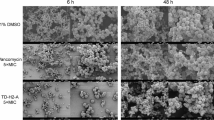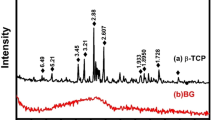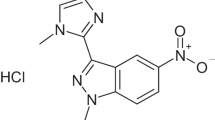Abstract
Triclabendazole (TBD) has been widely used in the treatment of helminthic infection. The anti-biofilm activity and antibacterial mechanism of TBD against Staphylococcus aureus were not known. Here, the anti-biofilm activity of TBD against clinical S. aureus isolates from China was systematically evaluated. Under TBD pressure, TBD-induced tolerant S. aureus with elevated TBD minimum inhibitory concentration (MIC) was selected in vitro and the genetic mutations between the parental isolates and TBD-induced tolerant derivatives were determined by whole-genome sequencing. TBD could significantly inhibit biofilm formation at sub-inhibitory concentration and disperse mature biofilm of clinical S. aureus isolates. In addition, TBD displayed bactericidal activity against the bacterial cells embedded in the biofilm and showed anti-persisters activity. Proteomic analysis showed that KEGG pathways of ABC transporters and beta-lactam resistance were significantly changed after TBD exposure. Moreover, SAUSA300_RS08395 (molecular chaperone DnaK), SAUSA300_RS11200 (sensor histidine kinase KdpD), SAUSA300_RS06325 (DNA translocase FtsK) were identified as candidate targets of TBD in S. aureus. Overexpression experiments further demonstrated that the elevated transcriptional level of DnaK resulted in S. aureus growth delay after exposure to a sub-MIC concentration of 1/2× MIC TBD. In conclusion, TBD exhibits antibacterial and anti-biofilm activity against S. aureus possibly by targeting the DnaK chaperone system.
This is a preview of subscription content, access via your institution
Access options
Subscribe to this journal
Receive 12 print issues and online access
$259.00 per year
only $21.58 per issue
Buy this article
- Purchase on SpringerLink
- Instant access to full article PDF
Prices may be subject to local taxes which are calculated during checkout





Similar content being viewed by others
Data availability
The raw whole-genome sequencing data was posted in the Sequence Read Archive (SRA) database under BioProject accession number PRJNA673936 in NCBI.
References
Tong SY, Davis JS, Eichenberger E, Holland TL, Fowler VG Jr. Staphylococcus aureus infections: Epidemiology, pathophysiology, clinical manifestations, and management. Clin Microbiol Rev. 2015;28:603–61.
Vestergaard M, Frees D, Ingmer H. Antibiotic resistance and the MRSA problem. Microbiol Spectr. 2019;7:7.2.18.
Schilcher K, Horswill AR. Staphylococcal biofilm development: Structure, regulation, and treatment strategies. Microbiol Mol Biol Rev. 2020;84:e00026–19.
Hall CW, Mah TF. Molecular mechanisms of biofilm-based antibiotic resistance and tolerance in pathogenic bacteria. FEMS Microbiol Rev. 2017;41:276–301.
Peyrusson F, Varet H, Nguyen TK, Legendre R, Sismeiro O, Coppée JY, et al. Intracellular Staphylococcus aureus persisters upon antibiotic exposure. Nat Commun. 2020;11:2200.
Abdelhady W, Bayer AS, Seidl K, Nast CC, Kiedrowski MR, Horswill AR, et al. Reduced vancomycin susceptibility in an in vitro catheter-related biofilm model correlates with poor therapeutic outcomes in experimental endocarditis due to methicillin-resistant Staphylococcus aureus. Antimicrobial Agents Chemother. 2013;57:1447–54.
Wilmaerts D, Windels EM, Verstraeten N, Michiels J. General mechanisms leading to persister formation and awakening. Trends Genet: Tig. 2019;35:401–11.
Pi H, Ogunniyi AD, Savaliya B, Nguyen HT, Page SW, Lacey E, et al. Repurposing of the fasciolicide triclabendazole to treat infections caused by staphylococcus spp. and vancomycin-resistant enterococci. Microorganisms. 2021;9:1697.
Institute CaLS. Performance standards for antimicrobial susceptibility testing: 24th Informational supplement. Wayne, PA: Clinical and Laboratory Standards Institute; 2016. Document M100-S26
Zheng J, Shang Y, Wu Y, Wu J, Chen J, Wang Z, et al. Diclazuril inhibits biofilm formation and hemolysis of Staphylococcus aureus. ACS Infect Dis. 2021;7:1690–701.
Sun X, Lin ZW, Hu XX, Yao WM, Bai B, Wang HY, et al. Biofilm formation in erythromycin-resistant Staphylococcus aureus and the relationship with antimicrobial susceptibility and molecular characteristics. Micro Pathog. 2018;124:47–53.
Charpentier E, Anton AI, Barry P, Alfonso B, Fang Y, Novick RP. Novel cassette-based shuttle vector system for gram-positive bacteria. Appl Environ Microbiol. 2004;70:6076–85.
Zheng JX, Tu HP, Sun X, Xu GJ, Chen JW, Deng QW, et al. In vitro activities of telithromycin against Staphylococcus aureus biofilms compared with azithromycin, clindamycin, vancomycin and daptomycin. J Med Microbiol. 2020;69:120–31.
Chong CR, Sullivan DJ Jr. New uses for old drugs. Nature. 2007;448:645–6.
Pushpakom S, Iorio F, Eyers PA, Escott KJ, Hopper S, Wells A, et al. Drug repurposing: Progress, challenges, and recommendations. Nat Rev Drug Discov. 2019;18:41–58.
Gandhi P, Schmitt EK, Chen CW, Samantray S, Venishetty VK, Hughes D. Triclabendazole in the treatment of human fascioliasis: A review. Trans R Soc Tropical Med Hyg. 2019;113:797–804.
Thakare R, Dasgupta A, Chopra S Triclabendazole for the treatment of fascioliasis. Drugs Today (Barc, Spain: 1998). 2019;55:743–52.
Koo H, Allan RN, Howlin RP, Stoodley P, Hall-Stoodley L. Targeting microbial biofilms: Current and prospective therapeutic strategies. Nat Rev Microbiol. 2017;15:740–55.
Mestorino N, Formentini EA, Lucas MF, Fernandez C, Modamio P, Hernández EM, et al. Pharmacokinetic disposition of triclabendazole in cattle and sheep; discrimination of the order and the rate of the absorption process of its active metabolite triclabendazole sulfoxide. Vet Res Commun. 2008;32:21–33.
Arita-Morioka K, Yamanaka K, Mizunoe Y, Ogura T, Sugimoto S. Novel strategy for biofilm inhibition by using small molecules targeting molecular chaperone DnaK. Antimicrobial Agents Chemother. 2015;59:633–41.
Fay A, Philip J, Saha P, Hendrickson RC, Glickman MS, Burns-Huang K. The DnaK chaperone system buffers the fitness cost of antibiotic resistance mutations in mycobacteria. mBio. 2021;12:e00123‐21.
Lee YJ, Shi R, Witt SN. The small molecule triclabendazole decreases the intracellular level of cyclic AMP and increases resistance to stress in Saccharomyces cerevisiae. PLoS ONE. 2013;8:e64337.
Sherratt DJ, Arciszewska LK, Crozat E, Graham JE, Grainge I. The Escherichia coli DNA translocase FtsK. Biochemical Soc Trans. 2010;38:395–8.
Wu LJ. It takes two DNA translocases to untangle chromosomes from the division septum. Mol Microbiol. 2009;74:773–6.
Veiga H, Pinho MG. Staphylococcus aureus requires at least one FtsK/SpoIIIE protein for correct chromosome segregation. Mol Microbiol. 2017;103:504–17.
Jennings LD, Foreman KW, Rush TS, Tsao DH, Mosyak L, Kincaid SL, et al. Combinatorial synthesis of substituted 3-(2-indolyl)piperidines and 2-phenyl indoles as inhibitors of ZipA-FtsZ interaction. Bioorg Medicinal Chem. 2004;12:5115–31.
Margalit DN, Romberg L, Mets RB, Hebert AM, Mitchison TJ, Kirschner MW, et al. Targeting cell division: Small-molecule inhibitors of FtsZ GTPase perturb cytokinetic ring assembly and induce bacterial lethality. Proc Natl Acad Sci USA. 2004;101:11821–6.
Kumar K, Awasthi D, Lee SY, Zanardi I, Ruzsicska B, Knudson S, et al. Novel trisubstituted benzimidazoles, targeting Mtb FtsZ, as a new class of antitubercular agents. J Medicinal Chem. 2011;54:374–81.
Sun N, Zheng YY, Du RL, Cai SY, Zhang K, So LY, et al. New application of tiplaxtinin as an effective FtsZ-targeting chemotype for an antimicrobial study. MedChemComm. 2017;8:1909–13.
Singh VK, Utaida S, Jackson LS, Jayaswal RK, Wilkinson BJ, Chamberlain NR. Role for dnaK locus in tolerance of multiple stresses in Staphylococcus aureus. Microbiology. 2007;153:3162–73.
Kelley JM, Elliott TP, Beddoe T, Anderson G, Skuce P, Spithill TW. Current Threat of Triclabendazole Resistance in Fasciola hepatica. Trends Parasitol. 2016;32:458–69.
Author contributions
ZW and QD conceived and design this study. JG, YZ, and HC performed the experiment. DL and ZW interpret the reference and provided the information about the background. ZY analyzed the data. JG, ZW, and QD wrote the paper. All authors reviewed the manuscript.
Funding
This work was supported by the following grants: National Natural Science Foundation of China (No. 82172283); Natural Science Foundation of Guangdong Province, China (No.2020A1515011049, 2021A1515011727); Sanming Project of Medicine in Shenzhen (No.SMGC201705029); Shenzhen Key Medical Discipline ConstructionFund (No.SZXK06162); Science, Technology and Innovation Commission of Shenzhen Municipality of key funds (JCYJ20180508162403996) and basic research funds (JCYJ20180302144431923; JCYJ20180302144721183; JCYJ20180302144340004; JCYJ20180302144345028); the Shenzhen Nanshan District Scientific Research Program of the People’s Republic of China (No. NS009, NS066, NS144, NS140, NS117.
Author information
Authors and Affiliations
Corresponding authors
Ethics declarations
Conflict of interest
The authors declare no competing interests.
Ethical approval
This study was approved by the Ethics Committee of Shenzhen Nanshan people’s Hospital, the 6th Affiliated Hospital of Shenzhen University Health Science Center. For this type of study, formal consent is not required.
Additional information
Publisher’s note Springer Nature remains neutral with regard to jurisdictional claims in published maps and institutional affiliations.
Supplementary information
41429_2022_515_MOESM2_ESM.jpg
Bacteria growth curve analysis of DnaK overexpression S. aureus isolate after treated with different concentrations of vancomycin
Rights and permissions
About this article
Cite this article
Guo, J., Zhang, Y., Cheng, H. et al. Inhibition of Staphylococcus aureus and biofilm formation by the anthelminthic drug, triclabendazole. J Antibiot 75, 287–295 (2022). https://doi.org/10.1038/s41429-022-00515-9
Received:
Revised:
Accepted:
Published:
Issue date:
DOI: https://doi.org/10.1038/s41429-022-00515-9
This article is cited by
-
Targeting ESKAPE pathogens with ZnS and Au@ZnS Core–Shell nanoconjugates for improved biofilm control
Scientific Reports (2025)
-
Repurposing TAK-285 as An Antibacterial Agent against Multidrug-Resistant Staphylococcus aureus by Targeting Cell Membrane
Current Microbiology (2025)
-
Antibacterial activity and mechanisms of D-3263 against Staphylococcus aureus
BMC Microbiology (2024)



